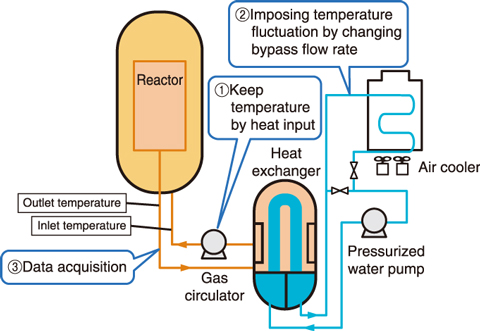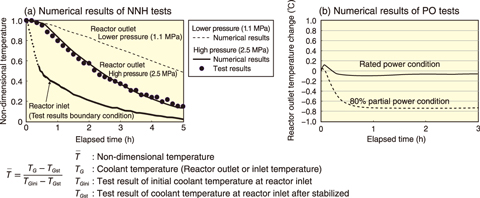
Fig.6-8 Non-nuclear heating (NNH) test on CTLFA using an HTTR during shutdown

Fig.6-9 Numerical results of NNH and powered operation (PO) tests for a HTTR
High Temperature Gas-cooled Reactors (HTGRs) have been used as heat source for heat utilization systems (HUSs) such as gas turbine power generation and hydrogen production systems. The HUS is requested to be constructed using non-nuclear grade standards (NNGS). This involves maintaining a stable operation regardless of the operational status of the HUS and to use a load-following operation (LFO), during which the delivered power can vary within a certain range to meet varying demands.
A LFO design of an HTGR was thus proposed by JAEA in which the coolant mass flow rate and inventory were controlled by changing the coolant pressure while keeping the reactor outlet temperature of coolant (ROTC) constant to supply helium gas to the HUS.
To make a construction of HUS using NNGS feasible, stable reactor operation must be ensured. This involves the ROTC remaining below the scrum alarm level (SAL), even when the fluctuation of coolant temperature is transferred to the reactor associated with an abnormal event (AE) occurring in the HUS, especially in the low-pressure condition (LPC) where the heat transfer rate from coolant to components is lowered during partial load operation by inventory control (IC).
The restriction effect of fluctuation in ROTC was then investigated in case that the reactor inlet temperature of coolant (RITC) is fluctuated after the numerical code RELAP5/MOD3 was improved to reproduce the effect using the test data acquired by the High Temperature Engineering Test Reactor (HTTR). Subsequently, it was confirmed that the reactor would remain operational when the RITC fluctuates, assuming a connection between the reactor and the HUS.
In the test using HTTR, the test data necessary to verify the code on the RITC and ROTC were acquired (Fig.6-8). The helium gas was heated by the compression of the helium gas circulator instead of nuclear heating because the HTTR was shut down. By considering the operational limitations, two coolant pressures (1.1 and 2.5 MPa) were selected to investigate the pressure dependency of characteristics of thermal load fluctuation absorption (CTLFA) by reactor. The AE occurrence in the HUS was simulated by changing heat release from the air cooler, in which the RITC was changed up to 30 ℃ in 6 hours. The results confirmed that the test results of the ROTC were well-reproduced; an example involving changing the RITC 10 ℃ under a high-pressure condition (HPC) is shown in Fig.6-9(a).
The pressure dependency of CTLFA was then investigated using the verified model, as shown in Fig.6-9(a). The ROTC varied more slowly under an LPC; the non-dimensional ROTC remained at approximately 0.5 for 5 hours, whereas it dipped to approximately 0.1 under an HTC. The heat capacity of the reactor side metallic components works as buffer material to absorb temperature fluctuation. This is because that the temperature change of components became still slower due to the heat transfer rate that is heat release lowered in LPC. Thus, the CTLFA by the reactor did not deteriorate, even in the LPC important in the LFO.
The transient characteristics of the ROTC were then numerically investigated using the heat transfer effect of reactor side metallic components; the results, shown in Fig.6-9(b), confirm that the reactor can be stably operated without scrum even in case that the RITC is fluctuated after an AE occurred in the HUS assumed connected to HTTR. The change of the ROTC remained below the SAL associated with the slower temperature transient lowering coolant pressure from 4.0 to 3.2 MPa by the IC.
Thus, the reactor was shown to have sufficient CTLFA, meeting the requirements for constructing HUS using NNGS, in which the ROTC does not exceed the SAL even when a fluctuating RITC is transferred to the reactor after an AE occurs in HUS, during the LFO of HTGRs.